Episode 146
What you’ll learn in this episode:
- How Whitney has maintained relationships with clients since moving her studio from Chicago to Lake Geneva, Wisconsin
- Why the pandemic has changed the way we buy and sell jewelry for good
- Why Whitney sometimes turns down commissions and encourages clients to work with other jewelers
- How social media has changed the type of jewelry customers want
- How to find creative ways to give clients a luxury experience when you can’t meet in person
About Whitney Abrams
Whitney Abrams’ high-karat gold creations are a reflection of her love of the Renaissance aesthetic and her admiration for the technical abilities of the Ancients. Inspired by the rich tones of high-karat gold and intense hues of unique, precious stones, her hand-made pieces involve the wearer in an experience of regal beauty.
Her interest in intaglios and cameos has led her to develop relationships with several German carvers who provide her clients with custom carvings that connect them with Abrams’ creations on an unparalleled level.
Whitney has studied goldsmithing and exhibited her jewelry throughout the United States and Europe. Her work is included in a number of publications on the subject of jewelry as an art form and jewelry making techniques.
Whitney Abrams presents her collections privately to collectors throughout the country, as well as online.
Photos:
These are thick felt pouches, made in Italy, that can accommodate earrings, rings or a necklace. Then the clients can use them for travel. People really love them!
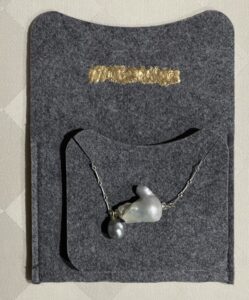
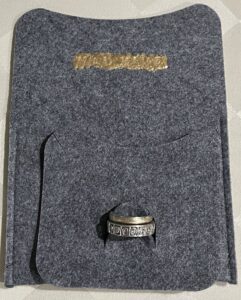
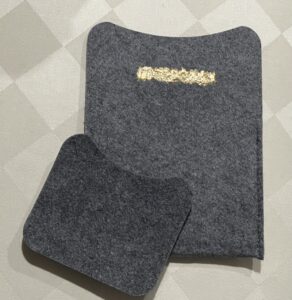
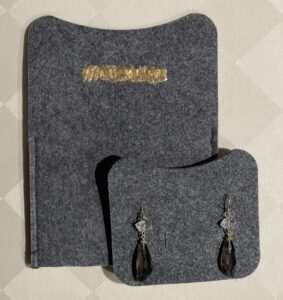
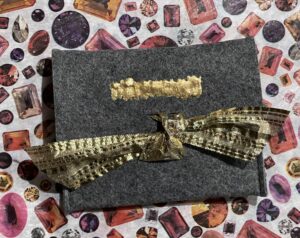
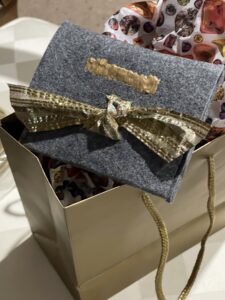
Additional Resources:
Transcript:
Since joining the Jewelry Journey Podcast as a guest in February 2020, maker and jewelry gallery owner Whitney Abrams’ life and business have changed dramatically: she moved away from her busy Chicago studio to vacation hotspot Lake Geneva, WI, and has spent the last year finding the inspiration that comes with a more relaxed lifestyle. Although it’s been challenging to provide customers with the luxury experience she’s known for in a pandemic, Whitney has discovered that the relationships she fostered with her customers can withstand the distance. She joined another episode of the Jewelry Journey Podcast to talk about what life is like in Lake Geneva; how she keeps in touch with longstanding clients; and how social media has helped her business grow. Read the episode transcript here.
Sharon: Hello, everyone. Welcome to the Jewelry Journey Podcast. This is the second part of a two-part episode. Today, my guest is Whitney Abrams, owner and founder of Whitney Abrams Jewelry, a private jewelry studio specializing in high-karat jewelry. If you haven’t heard part one, please go to TheJewelryJourney.com. Welcome back.
When people tell you they want something redone from old pieces, or if somebody dumps something on your desk and says, “O.K., here’s my grandmother’s ring,” do you see something visual immediately, or do you have to play with it? How does that work for you?
Whitney: Sometimes I do and sometimes I absolutely don’t. When I had my gallery, I was not in a place where people brought repairs. I didn’t change watch batteries or things like that. It was a jewelry gallery. I did have someone dump their teeth out on my jewelry counter one day, and I thought, “Well, this is a no. I’m not doing this.” I learned very early that if I didn’t have a connection with visualizing something or seeing something to make, or if I didn’t have a connection with the customer, that it was better for me to refer them to someone who could accomplish what they wanted to accomplish. Step one was setting a boundary and saying, “I don’t want to take this on because it never turns it out well.” I would much rather be spending time connecting with a piece, creating something meaningful for somebody.
Because I did that, I focused on creating a relationship with many of my clients. Even if it was an art piece I had already made that was in the case, if they came in and connected to it, that’s an introduction to creating a new relationship with that person, because they see something in you they relate to. When they would bring something in, I would design things and say, “What do you think of this?” I would do some drawings. If it was a fit, we would go with it, and sometimes it wasn’t.
Very rarely was it absolutely not how I wanted it to turn out, but it was a bit of a process. Sometimes it came very naturally, and sometimes when it really didn’t, I would say, “You know what? I think you need more of a bench jeweler,” or “You’re welcome to take these drawings and have somebody do whatever you want with them.” People can’t visualize the way they think they can, and then the end product is not going to be what they anticipated, which is the worst scenario you can be in doing anything custom.
It was always a thrill to have someone open up the box and say, “Oh, this is just what I wanted.” They have to take your life experience into it. If you know that putting something on a round chain is going to make it roll over when someone’s wearing it, I would advise them to put that on a flat chain. “No, I want a round chain.” “O.K., well, you’ll be back.” She said, “You said not a round chain, and I’m back. Put it on the flat chain.” That ended up being a seven or eight-year-long relationship at this point now. It could have gone the other way, but it didn’t. Sometimes I do say no to things.
Coming back around to Instagram, people have such a wide-open view of everybody’s jewelry that’s out there. You used to have to buy a magazine and look through it and see this designer or that designer, and only if they were lucky enough to get an editorial or pay for an ad were they in magazine. Now, it’s at everybody’s whim. They can scroll through and see designers they’ve never seen before.
I just had somebody say the other day, “I like these stones from my grandmother, but I like this girl’s jewelry.” She’s bought jewelry from me before and I’ve done custom things for her. I said, “That looks wonderful. If you like her jewelry, you need to contact her. I know she does custom. If you would like your piece to turn out looking like one of her pieces, then you need to contact her. I think that would be great. The next time you want something that’s more like what I do, please come back to me.” Then she said, “No, I changed my mind. I want it to look similar to my engagement ring.” I think the exposure people have to other artists is incredible and wonderful, but it brings a whole bunch of different design ideas into their minds that they never knew were possible. I don’t mind at all referring people to other people because in the end, you want that person to be happy.
Sharon: Do you find, because there are so many design ideas, that people come in and it’s a mishmash? “Today I want it to look like this designer’s jewelry, and tomorrow who knows.”
Whitney: I think sometimes people have homed in more than they think they have. If they come to me and say, “I kind of like this,” I’ll say, “Well, that’s not necessarily what I do, but let me show you some pieces I’ve done in the past.” I have hundreds and hundreds of images, probably thousands; I have never really thought about it. But I dig back and send them images of pieces I have made, and then they say, “Oh yeah, that’s great. I like that. I can see that.” Either they connect with it or they don’t; that’s fine too.
I’m definitely older in the business. When I started making jewelry, you had to have someone take professional slides and you had to get them printed. There was none of this instantaneous, “Oh, I have a phone with a camera, and I can send you a picture halfway around the world in two seconds.” Now that that’s available, it’s absolutely instrumental to my business. I think it has opened the doors for people to have more dreams about their pieces than they ever could before. Unless you had direct exposure to the people, you didn’t have the ability to see what the possibilities were.
Sharon: I know in the past when we’ve talked building a luxury experience, you had a private log. How do you keep that going in what you’re doing now?
Whitney: I don’t have the same personal interaction. It’s been a year since I moved. I’ve only met with a few people in person; I’m going to say less than 10 that I can think of off the top of my head. That’s definitely something I’m working on, and I don’t how it’s going to look. I tried to meet with a customer in November in a very lovely restaurant I love in Chicago, and she was nervous the whole time because she moved to a more rural area, and she wasn’t comfortable with all the people around here. I don’t have an office in Chicago anymore, so I’m going to have to figure something out there. It’s a little bit of a challenge and nothing I thought I would be facing.
For the moment, people seem to be happy with Zoom calls. They feel comfortable at their own house. I’ve upped my game in terms of my packaging, so the presentation when they receive something is nicer than before, and I think they appreciate that. I’ve had so many compliments on my new packaging, which has been nice because I did work on hard on it. I’m trying to lend a little extra where I can because I haven’t been able to be in person.
Sharon: If you can’t be in person all the time, how do you build a luxury experience? What do you do, like you’ve done with your packaging? What do you do over Instagram?
Whitney: I don’t know that it’s attainable to have a luxury experience over a screen or by scrolling through your phone and sitting in your car. I think we’re going to have to come back around, to wait for whatever’s going to happen with this virus so that people eventually can be back in touch with each other. When I thought things were calming down and we could get back to it, my ideas were to have a private room at an upscale restaurant, have food and drinks provided by the restaurant, and have a very small trunk show. That is very doable and very luxurious. People like to receive an invitation like that. Those are things I have on my to-do list, but I haven’t been able to do them yet.
I think the actual luxury experience you receive is when you come into a private jewelry store or salon, and someone offers you a glass of champagne and things like that while you shop. Unfortunately, we can’t have champagne through Instagram right now, but for the last two years, I’ve sent all my customers a Christmas/holiday gift that was jewelry related that they all loved. You know Julie and Amy from Juler’s Row. I had her do a dish for me last year, and I sent that out to all my customers, a little ring dish, and they loved that. This year I did something else. It’s all jewelry related, but it’s just in remembrance. It’s not only people that bought from me this year. It’s my long-term customers and the additional people that purchase. It comes from remembrance and, “Hey, I’m thinking about you. Hopefully we can see each other again soon.”
Sharon: I think having people know you remember them is so important. You mentioned earlier that when you first opened your store with other designers, some people were already collectors of yours. I guess the $64,000 question is what do you consider a collector? It’s such a hard thing to answer. What do you consider a collector?
Whitney: I think somebody that has a passion for a certain area of jewelry. Some people are a little more contemporary-based and some people are more interested in ancient, or they only buy antiques or they only collect pearls. They have to have a passion for it. They collect and add meaningful pieces to their collection. I had one customer who didn’t wear jewelry; she collected it to collect it, and she loved every piece. She has enormous amounts, a couple of different segments of jewelry, American Indian and some contemporary. It’s very interesting. So, I think a collector is somebody who has an eye for a certain thing they love, something they have a meaningful connection to. If they can afford to have whatever they want, good for them, and if they can’t, if they buy one piece a year, I think that’s great. Like you say, it’s a hard thing to answer.
I collect jewelry. When I go into a store—typically I would go into a gallery—I’m looking for things I connect to. I can’t believe how much jewelry I have in my business. I hardly have any of my own jewelry compared to what I have of other people’s jewelry. I have pieces by 15 or 20 different jewelers I’ve known over the years, things I see and love and I think, “I would love to own that. Hopefully I can buy that.”
Then I have things that mean a lot to me because they’re historical, like my John Paul Miller jewelry. Because my friendship with John is so meaningful to me, his pieces mean more to me than any other pieces of jewelry I have. I think if you have a personal connection with somebody, it makes it even more special. I have a couple of master jewelry idols of mine that I still hope to purchase a piece from.
Sharon: Do you wear most of your own stuff?
Whitney: I mix it up. My best person that wears my jewelry is my mom. She always has my jewelry on. She can be cleaning the garage with a four-ounce necklace on. It’s very funny. Everywhere we go, people will stop and say, “Your earrings are amazing.” She’ll say, “Oh, she made them.” She tells everybody. She’s always head-to-toe in my jewelry.
I do wear certain pieces of mine. I’m lucky enough to have my John Paul Millers. I do wear many of those pieces on a daily basis, which maybe I shouldn’t, but I don’t care. I enjoy them so much. Then I have other people’s jewelry that I mix in. Some days I will wake up and feel like wearing all my knockout jewelry, or a lot of contemporary pieces that are fun. Mostly I wear black clothing, so it’s easy to mix things in. It’s a mood; if I wake up and I want to wear this, or sometimes I realize I’ve been wearing the same earrings for three weeks.
Sharon: I didn’t realize there was another color besides black.
Whitney: Right, I know you well enough to know. It’s wonderful. It’s a great backdrop for everything.
Sharon: It is. I was sitting in the doctor’s waiting room yesterday with women who probably could have been my kids, but everybody had black on. I did too, and I thought, “Gosh, it is a backdrop. It’s a great backdrop.”
Whitney: Yeah.
Sharon: When you go back to Chicago once things turn around, what is your next step?
Whitney: My next step right now is to be in a holding pattern. So many people that know me are like, “What are you doing? You’re a New York/Chicago person; you’re a city person. How are you doing? Are you happy?” I love it up here. I can’t wait until the piers are put back in and I can go jump in the water. I think the last day I was in the water was October 19, which was late for some people up here. I spent a lot of time in the summer going up to Canada, staying on an island in the summer. I was an outdoor person when I was not in the city, but it’s a great lifestyle. You go down at night and watch the sunset off the pier.
For now, some of my things are still in storage, but I’m planning on getting the rest of my tools out. I have a very functional studio set up right now which I like a lot, so I’m planning on staying. I’ll see what happens in Chicago. Maybe I’ll do more of a pied-á-terre situation where I can be down there more, not in hotels and things like that. It’s a little bit up in the air, but so far, so good. I’ve met a lot of like-minded people with interesting jewelry up here, which has been wonderful, making a little community like that. But I’m still in touch with all my friends and customers, so we’ll do a trunk show up here or something.
Sharon: Is the kind of jewelry people look at up there different? Do you find a difference in people who are more outdoorsy?
Whitney: A lot of people up here wear silver jewelry. You would be surprised, not knowing anything about the area. One of the jewelry collectors in Chicago—I don’t know if you went to the Driehaus in Chicago.
Sharon: Yeah.
Whitney: O.K., so Richard Driehaus passed away in March. He had a big home up here. His home on the lake just sold for $41 million. There’s a home next to him for $21 million, and we’re not talking about little lake homes. There is a huge community of people that wear jewelry. There are incredibly successful jewelry stores up here that sell very high-end commercial lines you would find in Bergdorf’s or Saks, and they have boutique shops up here. It’s an enclave of people that have been here forever, people who have come in from Milwaukee and Chicago through the years, people who just come for the summer. People are flying here from New York City and not going to the Hamptons. It’s like Traverse City in Michigan. It’s very much that type of community, and there are very high-end restaurants and stores. It runs the gamut.
Sharon: Not log cabins.
Whitney: No, it is not. You don’t need your flashlight to go out at night.
Sharon: Are there jewelry galleries up there?
Whitney: I would say the closest to a jewelry gallery would be the Opal Man, which is a gemist who sells only opal jewelry, which is an interesting concept. There are other stores that will do repair, stringing and things like that, but then they have very high-end jewelry lines, lots of diamonds. They also have tourist jewelry that is geared around the lake, a charm of the lake with the location of someone’s house on it, things like that. There’s one woman whose specialty is equestrian jewelry. She only has equestrian customers. It’s very specialized, but there isn’t a jewelry gallery.
Some people have asked me, “Are you going to open a store there?” It would be a great place to have a store. That would be something I’d have to think about long and hard, because it’s harder to be at the lake for four or five hours a day if you have a store, and I really enjoy the lake. So, we’ll see what happens. It’s not anything I thought would happen, so it’s a new adventure, but it’s really nice.
Sharon: I admire your ability to roll with the punches. One question: what is your attraction to high-karat gold jewelry? Why not silver? What is it that attracts you?
Whitney: I love silver jewelry. I have a huge collection of silver jewelry starting from when I was little. I don’t know. It was an unbelievable feeling when I walked into that exhibition of Greek items. I was completely overcome. I knew it was a visceral reaction, my entire body, and I said, “This is what I’m going to do.” I don’t know where that came from. I had Greek history and things like that in school, but I never thought, “Oh, I have to have high-karat gold jewelry.” I was always attracted to other people’s work, like Bill Harper, John Paul Miller, things like that, which I had known about previous to seeing this exhibition, but I never thought, “Do I want to make that?” Once I saw this, I was so overcome. Then the Victoria & Albert Museum Vault Collection, when I walked in there and saw all these pieces I had seen in the past in books, when I saw them in person, I literally started crying. I thought the guard was going to kick me out or something, like “Who is this crazy person?”
I’ve always enjoyed working with it. I’ve never done sheer 24-karat; I’ve always done 22. The fact that you can fuse it, the fact that you don’t have to use solder and it’s so malleable and doesn’t fight you—if you want to set in an opal, you’re not pushing against 14-karat and hoping you don’t break the stone. It folds around it like butter. It’s such a pleasure that you can alloy your own metal and use different draw plates to make various shapes, if you’re lucky enough to have options in that respect.
It allows for a different form of creativity, but you’re also honoring the past. There’s always some sort of historical element that comes into any piece you make in 22-karat. You’re using granulation or chain making or fusion, things you cannot do with other karats, unless they’re specialized 18-karat fine silver, which you can granulate within chains very easily. I think part of it is the ease. I don’t make 14-karat gold jewelry, but sometimes even with 18-karat gold, I’m fighting with the sheet and it’s turning black because it has so much copper, and I’m used to very little copper. So, it’s an absolute pleasure to work with. I think once someone catches the bug of the buttery look of it, you can hold a piece of 14-karat next to it and think, “Ugh,” but if you saw the 14-karat piece on its own, you’d think, “That’s beautiful.” It’s just something that came over me. I’m not sure where it came from.
Sharon: Well, your jewelry is beautiful.
Whitney: Thank you.
Sharon: I appreciate you being here today and for rolling with the punches and being so flexible.
Whitney: I’m aware of the adventure I’m on.
Sharon: Whitney, thank you so much for being here.
Whitney: Thank you, Sharon. Great to speak with you again. Take care.
Sharon: You too, thanks.
Thank you again for listening. Please leave us a rating and review so we can help others start their own jewelry journey.

